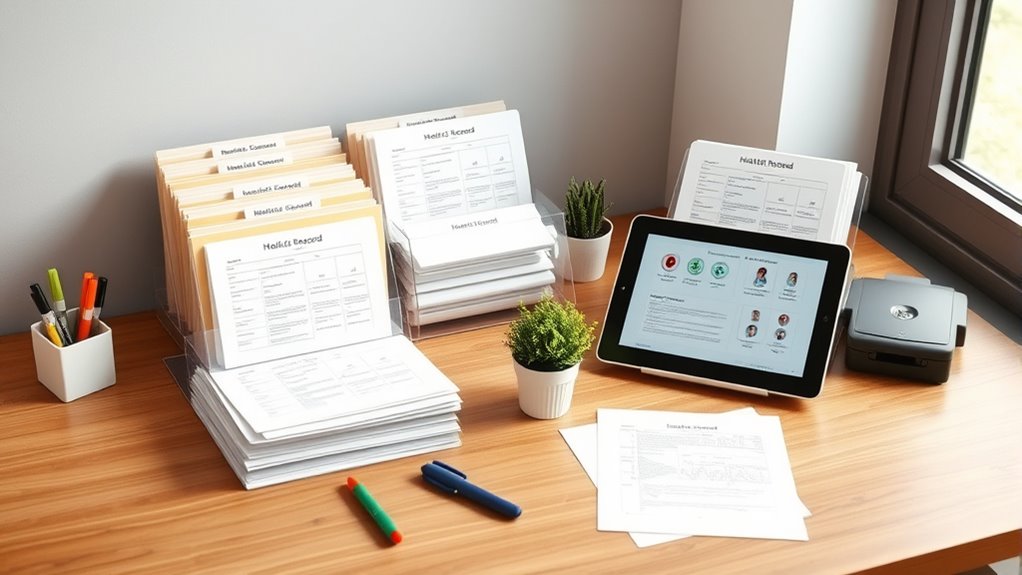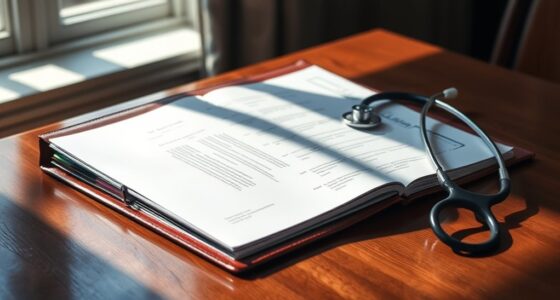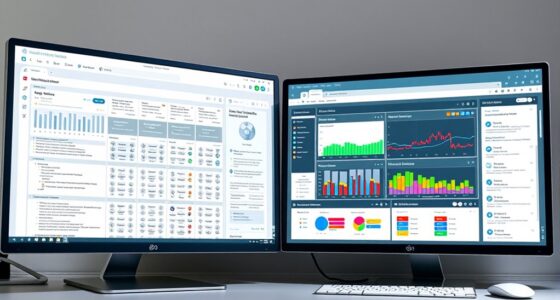To manage your medical records at home effectively, create a digital filing system using secure cloud storage or computer folders sorted by date or service type. Store paper copies in a fireproof, organized location, and keep a master list of physical documents. Regularly back up digital files and review both formats for accuracy and security. Using these best practices helps you stay organized and protected—continue to explore ways to enhance your record-keeping for peace of mind.
Key Takeaways
- Digitize records and organize them into clearly labeled folders by date, service type, or provider.
- Regularly back up digital files on secure cloud services or external drives.
- Use strong passwords, two-factor authentication, and encryption to protect digital medical records.
- Store physical documents in a fireproof, waterproof container and keep an organized master list.
- Maintain synchronization between digital and physical records for quick access and security.

Managing your medical records at home is essential for staying organized and ensuring you have quick access to important health information when you need it. The key is to develop a system that emphasizes digital organization, making it easier to locate documents and keep everything up-to-date. Using digital tools allows you to categorize records by date, type of service, or healthcare provider, reducing clutter and making retrieval simple. Create folders on your computer or cloud storage, labeling them clearly, so you can quickly find things like lab results, vaccination records, prescriptions, or visit summaries. Digital organization also minimizes the risk of losing paper copies, especially if you regularly back up your files on an external drive or secured cloud service.
However, while digital organization is convenient, safeguarding your privacy should be your top priority. Medical records contain sensitive information, so implementing privacy safeguards is vital. Use strong, unique passwords for your digital storage and enable two-factor authentication whenever possible. Consider encrypting files or using secure, password-protected folders to prevent unauthorized access. Be cautious about sharing access to your digital records—avoid storing everything on unsecured, public cloud services unless they have robust security measures. Regularly update your security settings and review who has access to your files. Additionally, when managing your records, avoid keeping copies of sensitive information on unprotected devices or unsecured networks. Employing privacy safeguards such as encryption and strong passwords helps protect your data from unauthorized access and potential breaches.
In addition to digital organization and privacy safeguards, physical copies should be handled with care. Store paper records in a secure, fireproof, and waterproof container, preferably in a designated area known only to you. Keep a master list of your physical records, noting where each document is stored, so you don’t waste time searching during emergencies or doctor visits. When you receive new records, file them promptly to prevent clutter and loss. Regularly review your physical files, discarding outdated or duplicate documents, and update your digital records accordingly.
Frequently Asked Questions
How Often Should I Update My Medical Records at Home?
You should update your medical records at home at least every six months to guarantee record accuracy. Regular updates help you stay current with recent treatments, medications, and health changes. If you experience a medical appointment, medication adjustment, or health event, update immediately. This frequency of updates keeps your records reliable and thorough, making it easier for healthcare providers to give you the best care possible and reducing potential errors.
What Digital Tools Are Safest for Storing Medical Information?
Think of digital tools as your digital vault. You want apps that use strong encryption methods, like AES-256, to keep your medical info secure. Look for platforms with automatic data backup strategies, ensuring your records stay safe even if your device fails. Trusted options include secure cloud services with end-to-end encryption and multi-factor authentication, so your sensitive info stays private and protected from cyber threats.
How Can I Securely Share My Records With Healthcare Providers?
You can securely share your records with healthcare providers by using encrypted email or secure patient portals that employ strong encryption methods. Make sure access controls are in place, giving only authorized personnel access to your information. Confirm that providers use HIPAA-compliant systems, and always verify their identity before sharing sensitive data. These steps help protect your privacy while ensuring your records reach the right hands safely.
What Should I Do if My Records Are Lost or Stolen?
If your records are lost or stolen, act quickly by reporting the theft to your healthcare provider and local authorities. Focus on record recovery by checking your backups or digital copies. Implement theft prevention measures, such as securing physical documents in a locked location and using encryption for digital files. Stay vigilant and regularly monitor your records to prevent identity theft or unauthorized access.
Are There Legal Considerations for Keeping Medical Records at Home?
Imagine your medical records are treasures; keeping them at home requires careful legal navigation. You must guarantee legal compliance and follow privacy regulations to protect sensitive information. Failing to do so could lead to legal trouble or privacy breaches. Stay informed about local laws, securely store records, and restrict access. By doing this, you respect your rights and safeguard your health data, turning your home storage into a secure, compliant space.
Conclusion
By organizing your medical records at home, you create a secure, easily accessible library of your health history. Imagine a neatly labeled file drawer, each document a page in your personal health story, ready to be found at a moment’s notice. With a little effort, you build a safe haven where your medical information is always within reach, giving you peace of mind and confidence whenever you need it most.









